Apple 15-inch MacBook Pro (Late 2011) Review
by Anand Lal Shimpi on November 17, 2011 5:10 PM EST- Posted in
- Mac
- Apple
- Intel
- MacBook Pro
- Sandy Bridge
- Laptops
Display Quality
The display hasn't changed since earlier this year, although this is the first 15-inch 2011 MacBook Pro that I've tested with the standard resolution (1440 x 900), glossy panel. Aesthetically I prefer this panel (I'm the rare case that isn't bothered by gloss) and the lower resolution is easier on my eyes, but for productivity I do feel the 1680 x 1050 upgrade is worth it. If this is going to be a workhorse, and you have good eyesight, get the high-res version.
As always, Apple calibrates its panels at the factory. Note the out-of-the-box white point across the 11-inch MacBook Air, 13-inch MacBook Air and 15-inch MacBook Pro:
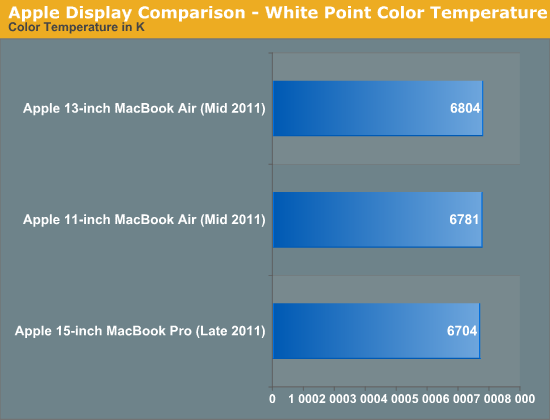
Apple wants to deliver as consistent of an experience as possible across its product line. While the Air models still don't have quite as high quality a panel as the Pro, at least there aren't any wide variations in what constitutes white on these panels.
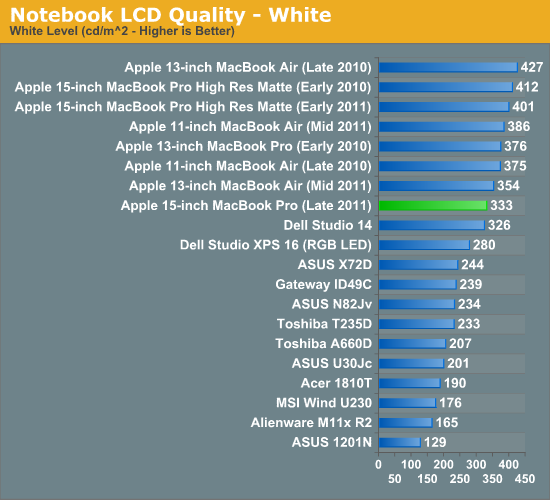
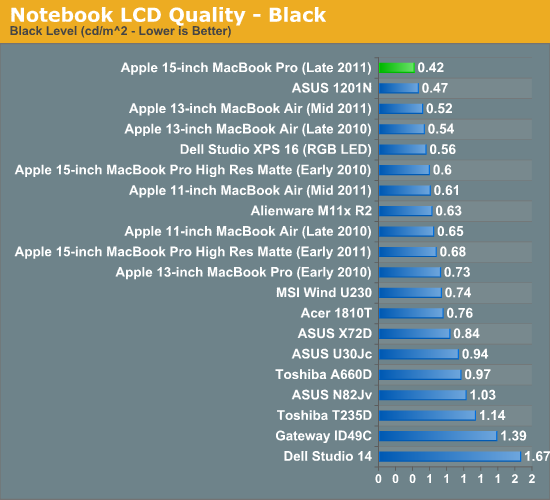
Brightness is down a bit compared to the high-res panel we looked at earlier this year, but so are black levels. The combination of the two actually results in a slightly higher contrast ratio than what we measured on the early 2011 models. In practice the panel looks just as good and seems to get just as blindingly bright as my personal 15-inch.
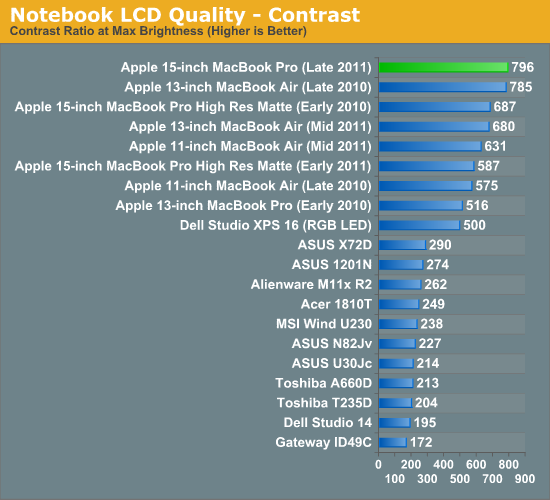
Color quality and gamut are virtually identical as well, no surprises here:
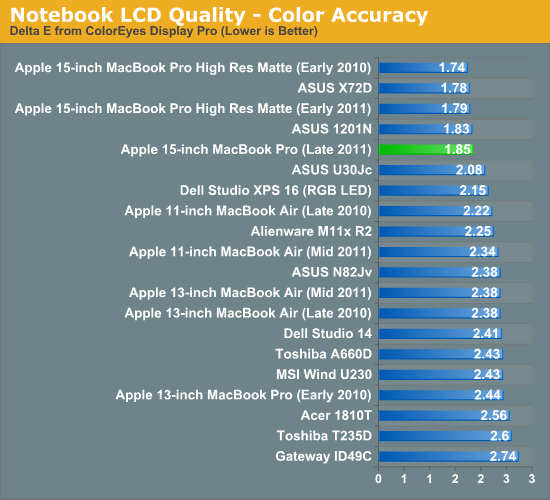

Hard Drive
The more traditional Macs (MBP, Mac Pro, iMac) continue to ship with mechanical hard drives by default, the late 2011 update is no different. My review sample came with a 5400RPM Toshiba MK5064GSXF. The drive features two 320GB platters (obviously not all in use for the 500GB capacity), and an 8MB cache.
All of my personal systems use SSDs and in testing the new MBP with a hard drive I can only say that the move back is more painful than ever. It's most noticeable when multitasking. Installing applications while browsing the web and copying files just seems to slow to a crawl compared to my SSD equipped MacBook Pro. If you're going to buy any new machine, especially if you're paying top dollar for something you expect to feel fast, you definitely need an SSD.

The good news is Apple's SSD pricing isn't horribly unreasonable, at least at the beginning. For $200 you can upgrade the 15-inch MacBook Pro to a 128GB drive (most likely a 3Gbps Samsung based SSD). It's when you look at the 256GB or larger drives that you're probably better off buying your own. You can buy a 256GB Crucial m4 for under $400 today, and a 240GB Vertex 3 will set you back around $460. Both options are cheaper (and faster) than Apple's $600 256GB upgrade. If you get the high-end 15-inch MBP model however, the upgrade prices drop by $100 - making the Apple route much more cost competitive. You don't get the same performance you would from an aftermarket drive, but with less headaches and potential for issues it's possibly a better route.
The 512GB drives are most definitely not a bargain from Apple. To equip a 15-inch MBP with a 512GB SSD, Apple wants $1200. You're much better off buying a 512GB Samsung SSD 830 for under $800 and pocketing the difference.
| Apple SSD Upgrade Pricing | |||||
| 128GB | 256GB | 512GB | |||
| 13-inch 2011 MacBook Pro | $200 | $600 | $1200 | ||
| 13-inch 2011 MacBook Pro (high end) | $100 | $500 | $1100 | ||
| 15-inch 2011 MacBook Pro | $200 | $600 | $1200 | ||
| 15-inch 2011 MacBook Pro (high end) | $100 | $500 | $1100 | ||
| 17-inch 2011 MacBook Pro | $100 | $500 | $1100 | ||
What aftermarket SSD should you buy? If you want to play it safe and hang on to TRIM support, go with Apple. Ever since I've been reviewed SSDs however I've run aftermarket SSDs in my Macs, mostly without any major issues. I can vouch for the Intel SSD 510, Samsung SSD 830 and OCZ Vertex 3. At one point or another I've used all of them in my 2011 MacBook Pro. My current setup is a Samsung 830 in the primary drive bay and an Intel SSD 510 in place of my optical drive, the combination works wonderfully.
Still Great WiFi
Apple continues to quietly focus on delivering excellent WiFi performance with the MacBook Pro. In the late 2011 models WiFi is still powered by Broadcom's BCM4331 3x3 solution. A quick test with a 3rd generation Time Capsule showed us peak transfer rates of 154Mbps, in line with what we've seen with the first generation Sandy Bridge MacBook Pro.

Despite Apple's move to Bluetooth 4.0 support on some of its other platforms, the MacBook Pro remains at 2.1 with the same BCM2070 controller.
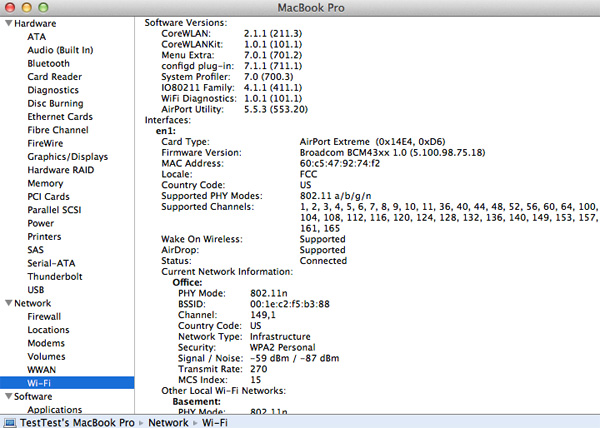


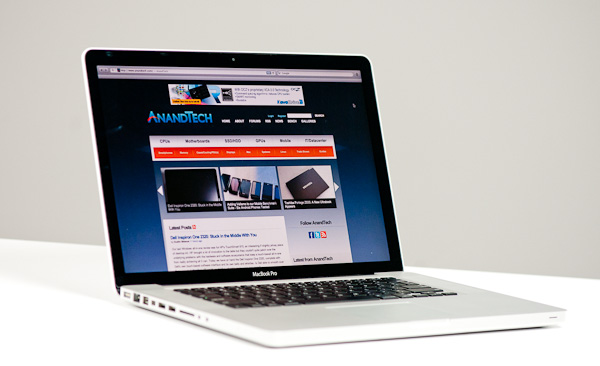








101 Comments
View All Comments
james.jwb - Friday, November 18, 2011 - link
Yep.Big audience here where some (read: most) stay out of the silliness and others only take part in the silliness. The Mac reviews--just like PS3 vs Xbox, COD vs BF3--attracts a certain type of.... weird individual that needs to rethink a few things about their deep emotional attachment to little boxes with plugs, in my opinion.
I don't blame some for defending their positions when attacked by these crazy, biased people, because it's quite annoying and borderline trolling, and sometimes it's hard not to let loose and troll a troll back.
But to grown ups it reads as tiresomely embarrassing drivel and just looks like there is something wrong with some people, which is likely.
ananduser - Sunday, November 20, 2011 - link
This is(was) a site for tech enthusiasts. They traditionally are against pre-configured machines and more into the hardware side of things. Apple reviews are fine but the mac users that comment on those Apple related articles, more often that not, do not address the tech side of that said Apple machine. They are almost always something like "...which is why Apple will always win against..." or "...why cant other brand makers do this...".freespace303 - Friday, November 18, 2011 - link
No 6770m benches for us windows gaming lovers eh? :(I would love to see how this laptop handles BF3 and Skyrim.
KoolAidMan1 - Friday, November 18, 2011 - link
Same, I'd love to see how the 6770m compared with the 6750m.Death666Angel - Friday, November 18, 2011 - link
"My current setup is a Samsung 830 in the primary drive bay and an Intel SSD 510 in place of my optical drive"You are such an SSD hog! Most people are still finding it hard to put one SSD in their case because of the prices. :D
Otherwise, good read.
Torrijos - Friday, November 18, 2011 - link
Anand should really try to review Mac Hardware with a bunch of Windows benchmark too, just to gage where they sit compared to the windows crowd, reducing OS & software optimization influence on the measures.This would be particularly interesting with the advent of the ultrabook where the MBA seems to be the reference but doesn't show up in any of the charts of the ultrabook reviews.
This would also reduce speculation on hardware performance benchmarks the only nagging point remaining would be the drivers given by Apple.
Death666Angel - Friday, November 18, 2011 - link
I agree! While I am unfortunately not in the market for such a thing while I'm still a student (another year or two), some of the MBPs do look nice and offer good performance. But I would not use OSX with them. So a comparison with bootcamp Windows would be appreciated. :-)KoolAidMan1 - Friday, November 18, 2011 - link
1:1 comparisons in the past have yielded consistent results in terms of battery life and game performance. Windows gets less battery life along with better game performance, the latter due to GPU drivers from vendors being much more optimized than the OpenGL drivers Apple puts out themselves. There were several updates from Apple last year when Valve ported Source games to OS X that yielded very good improvement, but it's still generally not as good as DirectX performance in Windows. There are a few exceptions like WoW, but then you have games like Starcraft 2 where the differences seem to swing wildly depending on the version number.Doesn't affect me much personally, I segregate work to my OS X machine and play to my Windows box. :)
ananduser - Friday, November 18, 2011 - link
Load of bull. DirectX and OpenGL performance in Windows is a no contest compared to Apple's. It all amounts to Apple's shitty bootcamp. Apple's drivers for Windows don't use the integrated graphics at all - they just turn on (and leave on) the discrete GPU - even if your machine doesn't need the graphics horsepower - hence the battery penalty. Apple also only provides Windows IO drivers that make the HDD subsystem look like an old IDE drive, reducing IO bandwidth and increasing IO latency considerably. Legacy IDE mode hinders the performance of all disk IO.KoolAidMan1 - Friday, November 18, 2011 - link
Yes, I'm fully aware that those are reasons for Windows performance having less battery life than OS X. That said, I didn't go into that, instead focusing on differences in graphics performance (Windows DX drivers are more optimized than OS X OGL drivers) which we do agree one, even though your response makes it seem like we don't.The one thing you do need to consider is Anandtech's battery tests on Macbooks without dedicated graphics. Even with an integrated GPU, battery life is more with OS X. Furthermore, Boot Camp battery life is roughly in line with other notebooks running identical specs: http://www.anandtech.com/show/2645/13
Why are you so mad? These aren't major disagreements we're having.